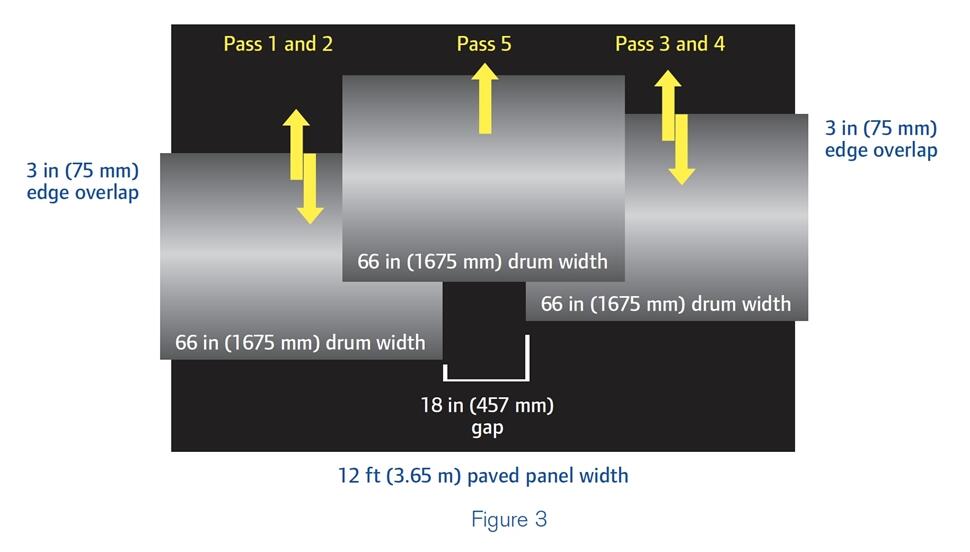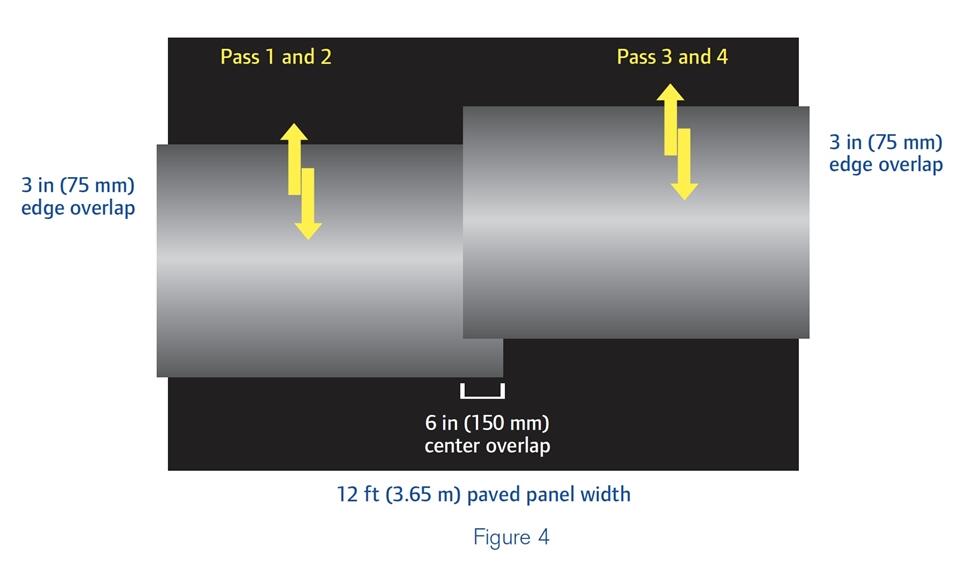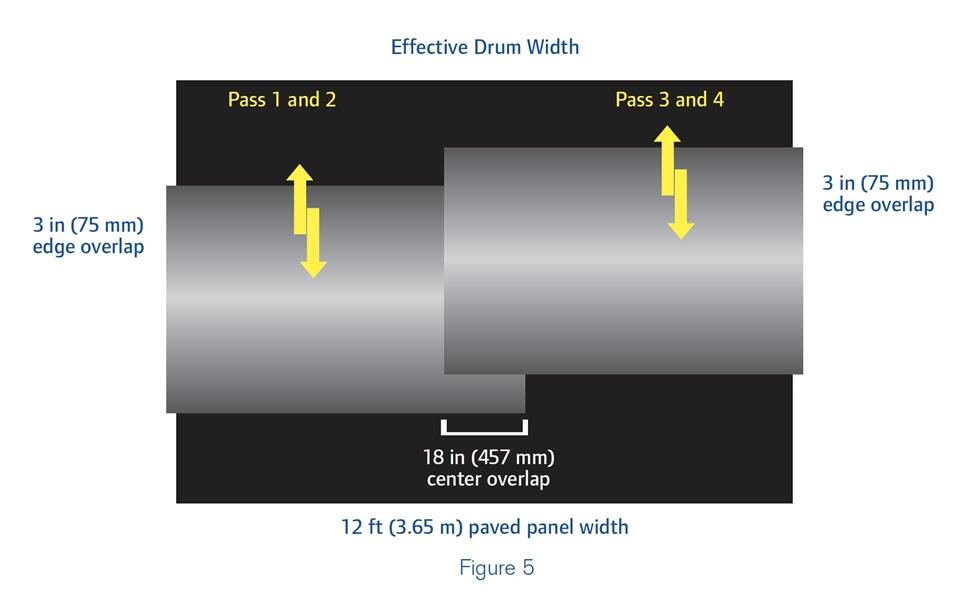Asphalt Compaction Rolling Patterns to Help Achieve Target Density and Production

Paving contractors know a lot about the mix they’ll use on projects. Most of them know exactly how many tons of mix the asphalt plant can produce on an hourly basis. They know the storage capacity of the silos, and they determine whether the plant will be providing mix for only one project or for multiple projects at the same time. When a contractor must buy mix from a producer, the number of tons of mix to be purchased is usually a contract item and of predictable supply.
Contractors also know the size and capacity of the transport trucks used to deliver hot mix asphalt (HMA) to the project. From experience, contractors estimate the round-trip transportation time from the plant to the jobsite and determine how many loads each truck can deliver per unit of time.
But when it comes to laydown and asphalt compaction, predictions on productivity are less certain. Especially for compaction, the variables of how much HMA is produced and when it’s delivered influence the temperature of the asphalt when compacted. Mix temperature is the most critical element in compaction. Keeping compactors in the proper rolling zone to achieve target density requires the right asphalt rolling patterns.
BEST PRACTICES OF ASPHALT COMPACTION
Compactor manufacturers teach several operator procedures to increase productivity. Because nearly all breakdown rolling today utilizes vibratory double-drum compactors, the following best practices concentrate on operating this type of compactor.
Make the first pass toward the paver with vibration on.
The first pass achieves the most air void reduction because the mix viscosity is low and the ability to rearrange aggregate particles into closer orientation is high. If the edge of the pavement is supported against lateral movement, the operator should slightly overlap the joint between cold and hot panels. The more skilled the operator, the narrower the overlap of the joint needed. Most operators need only 3 to 4 inches (75 to 100 millimeters) of overlap. If the edge of the pavement is unsupported, the operator should make this first pass 6 to 8 inches (150 to 200 millimeters) away from the edge to reduce lateral shoving of the mat. Stiffer mixes may not require this precaution. Figure 1 shows the proper drum orientation to the pavement on the first pass.

Stop forward motion of the compactor, rolling in a slight arc toward the center of the panel, a safe distance behind the paver and crew.
The reason for stopping on an angle is to facilitate rolling out drum depressions on the next pass. This helps prevent formation of bumps on the pavement. Figure 2 shows the technique. The pass on the left side of the panel stops in an arc and the compactor returns on the same path. The next forward pass is on the right side of the panel, passing the previous forward pass, with an arc toward the center of the panel. This technique permits the compactor to achieve more uniform density by staying in the same range of temperature with each side-by-side pass.

Roll the end of each subsequent pass beyond the end of the adjacent and previous pass.
This is also shown in Figure 2. Following the forward motion of the paver keeps the breakdown compactor in the same relative temperature range of the mat as the paver. Limiting the length of the breakdown asphalt rolling zone helps the front compactor keep up with the paver. There is no more important technique in compaction, especially for stone mastic asphalt (SMA) and Superpave mixes.
ACHIEVING OPTIMAL ASPHALT DENSITY
Complete breakdown rolling before the mix cools below a temperature consistent with achieving target density. This technique accomplishes two objectives. For most mixes, it permits the highest production to be achieved. For those mixes that exhibit tenderness, this permits density to be reached before the mix begins to exhibit instability.
Compact the joint for uniform density. One of the more common deficiencies found in HMA pavements is low joint density. Low density at the joint is caused by poor paving technique, excessive luting and raking, poor rolling practice or a combination of these. Poor rolling practice can be overcome by proper training of compactor operators and through experience.
SELECTING A COMPACTOR BASED ON EFFECTIVE ROLLING WIDTH
The length of the compactor drum is not the true measure of the productive capacity of the compactor. Rather, effective drum width (EDW) is the important metric. The difference between EDW and drum length can be significant. Generally, these two dimensions are within 10 percent. Several examples in Figure 3 show this relationship.

The width of the paved panel in Figure 3 requires three side-by-side passes of the compactor to provide complete coverage. Unfortunately, even the best operator will fail to achieve uniform pavement density when making a rolling pattern like the one shown, since the compaction forces are not evenly applied across the width of the panel. The fifth pass overlaps the pavement surfaces compacted during the first four passes but gives only a single pass over the middle 18 inches (457 millimeters) of the panel. This means density will be lowest in the center, slightly higher at the outer quarters of the panel, and highest in the sections where three drum passes were made. This doesn’t meet the necessary requirements. The narrow rolling width also interferes with the ability of the operator to keep up with the paver.
Notice in Figure 4 that only two side-by-side passes are needed to completely cover the same panel width from Figure 3. This is due to a compactor with a wider EDW. The well-trained operator on a compactor with 78-inch (1980-millimeter) drums can compact the panel with uniform coverage except in the exact center where the side-by-side passes overlap slightly. Using this breakdown rolling technique will achieve uniform density across the panel and help achieve requirements.

It’s also possible to have drums that are too wide for the panel. In Figure 5, the compactor drums are 84 inches (2135 millimeters) wide.

The center of the panel is receiving twice as much compaction force as the outer sections. Because a compactor with drums too wide for the pavement was used, breakdown rolling results will fail to achieve requirements. In addition, the larger compactor has higher ownership and operating costs, so there’s reduced payback to the contractor on the investment.
This is the reason nearly all manufacturers produce highway-class compactors with drums in three basic widths: 66, 78 and 84 inches (1675, 1980 and 2135 millimeters).
The major contribution of the compactor to the paving train is the ability to achieve density. Selecting a compactor size is sometimes based on what’s in a contractor’s fleet. Since keeping up with the paver is as important as achieving uniform density, attention to compactor selection and rolling patterns yields benefits, especially in the success of achieving specifications.
Learn more about the basics of asphalt compaction.